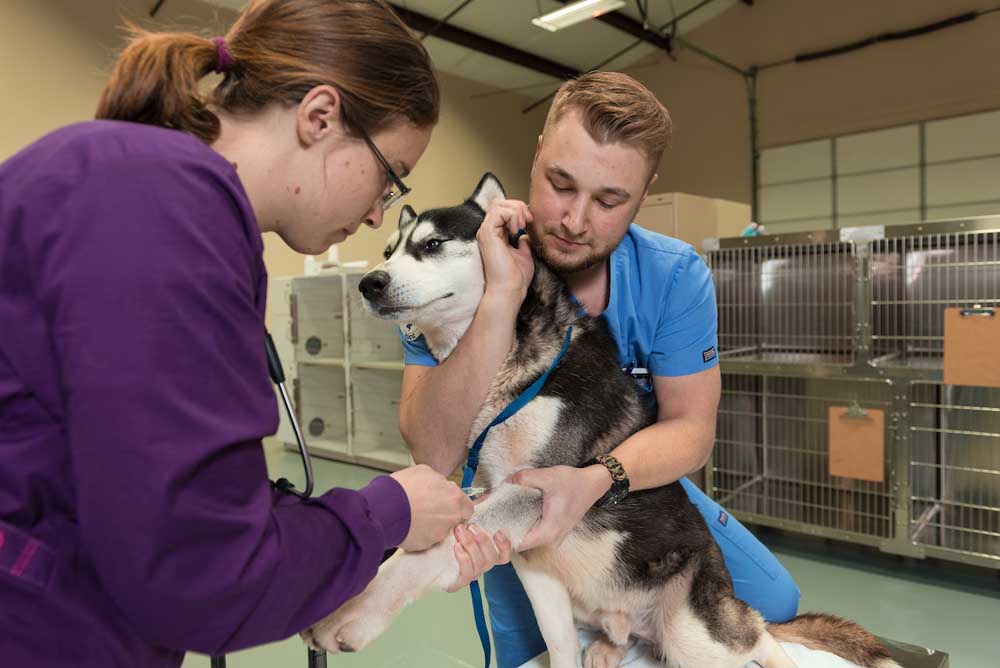Sponsored Content
A Deep Degree of Animal Care
Published 8:17 am Tuesday, March 4, 2025

- The rigorous two-year degree includes three separate three-week internships
All eyes are fixed on six students of Central Oregon Community College’s (COCC) Veterinary Technician program— dressed in dark blue scrubs, some with stethoscopes draped across their necks — as they quietly enter the space at BrightSide Animal Center in Redmond. The welcoming committee, peering curiously out from stacked pens in the cat room, includes Eva, Finley and Truffle — all awaiting adoption but serving as training volunteers in the meantime. A few soft meows break the silence.
Trending
“Today’s lab is getting to know the cats, evaluating their fear, anxiety and stress,” says Beth Palmer, program director, standing beside an immense scratching tower and turning on some soft music. The day’s exercise is focused on restraint techniques: safely, securely holding and positioning a feline patient for things like blood draws and catheter placements.
Trending
And the clock is ticking. The term “kitty minutes” might sound innocent enough, but it refers to how long a cat’s patience will typically hold out during an examination. It’s usually about 10. Having started their morning lab at the college’s training center next door, using a plush cat doll for the demo, the students are ready for the real deal: the squirmy-and-mostly-soft-but-potentially-prickly deal.
Students pair up and fan out, selecting whiskered lab partners. Petting and soothing with low voices, they put the cats at ease with soft food squeezed from tubes or a quick spritz from a stress-relieving pheromone spray. Then they practice a variety of calming restraint techniques likea forearm clamp method, lifting and laying the cats sideways in one easy motion. They try out a firm downward press, containing the cats upon their bellies. Or, chin atop feline head, they brace them tight.
Together with Palmer, Daisy Altamirano, a recent graduate and now a part-time program instructor, observes the techniques and provides guidance. She knows that next term the students will be doing blood draws and taking bigger strides in learning.
“We get set up really well,” says Altamirano of the rigorous two-year degree, which includes three separate three-week internships — in locales ranging from Hawaii to Kentucky. Her own internships, which saw her performing blood work for buffaloes and anesthesia for lions at a 600-acre zoo near Roseburg, positioned her for a job with the emergency department of Bend’s Veterinary Referral Center of Central Oregon. The immersive, on-site aspect of the internships, Altamirano shares, not only refines skills but opens eyes to different career options, such as research, wildlife rehabilitation and specialty practices.
Vet techs assist veterinarians in treating patients, with responsibilities that might include radiology, dental care, sutures, lab work and surgery prep. It’s a very science- and math-driven career, ideal for challenge-seekers who love animals.
As one of only two American Veterinary Medical Association-accredited educations in Oregon — first opened in 2013 — the COCC program is about to enter a new era. With the demand for vet techs rising both regionally and nationally, the program is shifting from an every-other-year format to a yearly cohort start, with up to 20 students teamed-up each fall.
With the demand for vet techs rising both regionally and nationally, the program is shifting from an every-other-year format to a yearly cohort start.
“We’re being recognized as a place with a stellar reputation,” says Palmer, who points out that her current students have come from places like Washington and Nebraska, drawn to COCC in part by the fact that grads of the program have hit a 100% passing rate on the national exam since 2018. (Veterinary technicians must pass both a national and state credentialing exam.)
In addition to the partnership with BrightSide, where students learn about diagnostic testing and care methods while providing shelter animals with checkups, training takes place on the Redmond campus and in the clinic-like training center, with some labs overseen by Cierra Buer, the program’s veterinarian. “We run it like an animal hospital,” adds Palmer of the ultra-realistic setting.
It’s a professional, welcoming space. A placard stickered to the animal-food fridge states the veterinary technicia
n’s oath: “I solemnly dedicate myself to aiding animals and society by providing excellent care and services for animals, by alleviating animal suffering and by promoting public health.” Large-scale paintings of animals, like a pig and a Basset hound, fill the space. The camaraderie of the cohort-style education includes a club that meets monthly to make homemade dog treats and blankets for animal shelters.
The application for a September start is due May 1. Before students can enter the program, they need to have a set list of prerequisite courses already taken or underway: in writing, speech, chemistry, biology and algebra. Many local high school students who participate in COCC’s College Now program, Palmer explains, would likely already some of the credits. Another stipulation is that hopeful students need to job-shadow or observe at a veterinary practice for 40 hours.
A series of upcoming Zoom-based information sessions (March 4, March 8, March 11 and April 2) will offer a program overview and answer specifics. Contact bpalmer@cocc.edu to sign up for a session or ask for more info. For full details on the Veterinary Technician program, visit cocc.edu/programs/vet-tech.








